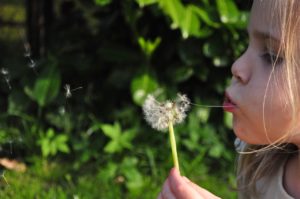Mindfulness – focussing on feelings and being present – often comes up as an antidote to our stressful, busy adult lives, but did you know it can also be beneficial for children?
You might feel like you have enough to do, cooking and bathing and tidying and disciplining and making sure they don’t grow up to be little creeps; who on earth has time to even consider mindfulness for children? The good news is, it’s really not that difficult and the benefits are certainly worthwhile, helping kids to build resilience, manage stress and regulate their emotions.
What is Mindfulness?
Mindfulness is focussing on one, usually sensory, point to help the body and mind to slow down. It involves directing attention to the point of focus and this exact moment in time, instead of thinking about anything else.
Useful sensory anchors could be the rhythm of your breath, a word or phrase you repeat in your head, the feeling of something under your fingertips, a regular sound such as ticking or birds singing, or looking at the details of a leaf or flower.
Mindfulness helps kids to regulate their emotions and manage how they feel and react in many different kinds of situations. But you can’t really introduce mindfulness activities when your child is in the middle of a meltdown – it is best to get them to practice mindfulness often when they are calm and content to help them master the skill.

Why is Mindfulness Good for Kids?
It can be very hard to tell all the time what your child wants – especially when he doesn’t know himself. Tears, tantrums, hitting and shouting can come from your child not because he is naughty, but because he is trying to express something and he doesn’t know how.
Almost all challenging behaviours from children happen because there is some sort of message that needs to get out.
Do you ever find yourself saying to your child, ‘Stop crying!’ or ‘Control your anger’ or ‘Don’t be scared, there is nothing to be afraid of’? We are sometimes guilty of teaching our children that certain emotions are unacceptable or wrong and should be avoided or shut down.
Through mindfulness, we recognise that all emotions are valid and all of them are normal for human beings to feel. Mindfulness helps kids to understand that all emotions are normal and acceptable, as well as how to deal with them.
Mindfulness Teaches Your Child To:
- calm their body during moments of heightened or unmanageable emotion
- identify the emotion they are feeling
- stop judging or criticising themselves for feeling this way
- figure out what their body is trying to tell them
- figure out a better way to express themselves.
Now all of that sounds amazing, really, so it might be well worth giving mindfulness activities a try.
When a child is being mindful they are slowing their mind and body down through sensory focusing activities. They learn to calm themselves in all sorts of situations and recognise what emotions they are feeling. They get better at trying to figure out what their body is trying to tell them.

When practised properly, mindfulness teaches children how to separate themselves from their body’s automatic thoughts and fears. They learn how to notice when their mind is jumping to conclusions or their body is scared without reason, and they learn to control their reactions to these kinds of feelings.
They also learn how to view themselves with greater compassion and kindness, and without judgement.
It helps people to really listen to others and take retain information. It improves focus and reduces distractibility, and encourages learning skills. It also helps us to get along with other people by showing greater empathy and understanding of what they are feeling, as well as improving patience.
All of these skills will be incredibly useful as they grow into adults.
But it does take regular practise when they aren’t stressed to get a handle on the skills to then put them into practice in emotional moments.
Easy Mindfulness Activities for Kids
Every mindful activity has the same basic steps, and there are literally countless ways you can implement them into your child’s day. If one kind of focal point or activity doesn’t really work for your child, try another.

Basic Mindfulness Steps:
- Choose a sensory anchor to focus on (such as colouring a picture, saying a word over and over, listening to your breath)
- Be still and breathe in and out evenly, while focusing your mind on the anchor. Pay attention to the point of focus and notice everything you can about its appearance and your experience – describing details about the anchor is a good way to do this.
- Your mind will naturally wander to other things. As it wanders, recognise that it has done so, without getting upset about it, because that’s just what minds do. Gently bring your attention back to the anchor point.
- Start by doing this for a couple of minutes, and increase your skill to be able to do this for five, ten and even fifteen minutes. Try to do this every day.
Try these easy activities with your children.
Eating
This one combines snack time! Cut up several different foods in squares or pieces to suit your child, such as cheese, grapes, cherry tomatoes, mandarin, celery etc.
Get your child to place one item of food in their mouth at a time, and focus on the full sensory experience of each piece.
What does it feel like in their fingers? What colour or shape is it? What does it smell like? Taste like? Feel like in their mouth or on their tongue? Do they hear a sound when they are eating it? What words can they think of to describe the feelings they get from each piece of food?
Breathing
Use a whistle with a roll-out paper attached, or a paper pinwheel, and encourage your child to blow in and then out to make the item move. Count or say something with each breathe such as ‘One, two’ or perhaps ‘In breath, out breath’.
Get them to place their hands on their belly and try to feel it rising and falling with each breath.
Counting
Lay out seven different stones, stickers or different shaped buttons for your child. Get him to count each one slowly one at a time, breathing in and out for each number. Get him to focus on his breath, the feeling on each stone/button under his finger, and say the colour or shape of the item in his head as well.
Art
Do a mindful colouring activity by setting out a picture that interests your child and give him several crayons, pencils or markers. Ask him to colour each section in a different colour, taking care to stay within the lines as best he can.
As him to pay attention to the feeling of the pencil between his fingers, the pressure pushing on the page and the effect of the colouring strokes on the paper. He could also say the colour that he is colouring in over and over with each breath.

Gratitude Journaling
Buy your child a pretty notebook, or even get a plain one and help them to decorate the front with pictures that they like. This is their gratitude journal, and the idea is to write every day several things that your child is thankful for that day.
Encourage them to get creative and descriptive with their items, and make sure that they don’t repeat themselves. You could start with naming three things every day and then as their skill builds, or for older kids, work up to five or seven items.
Items could include ‘warm fluffy pyjamas fresh from the dryer’, ‘making hot chocolate with my Mum’ or ‘the bright colours in my favourite superhero poster’ for example.
Mindfulness Apps for Kids
There are also some great apps available to help kids with mindfulness, such as:
- Moshi Twilight
- Breathe, Think Do Sesame
- DreamyKid
- Headspace
- Smiling Mind
- Calm
